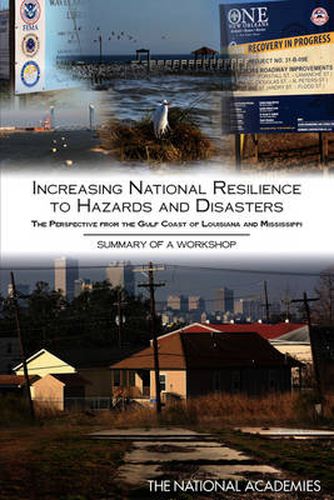Readings Newsletter
Become a Readings Member to make your shopping experience even easier.
Sign in or sign up for free!
You’re not far away from qualifying for FREE standard shipping within Australia
You’ve qualified for FREE standard shipping within Australia
The cart is loading…






Natural disasters are having an increasing effect on the lives of people in the United States and throughout the world. Every decade, property damage caused by natural disasters and hazards doubles or triples in the United States. More than half of the U.S. population lives within 50 miles of a coast, and all Americans are at risk from such hazards as fires, earthquakes, floods, and wind. The year 2010 saw 950 natural catastrophes around the world–the second highest annual total ever–with overall losses estimated at $130 billion. The increasing impact of natural disasters and hazards points to increasing importance of resilience, the ability to prepare and plan for, absorb, recover from, or more successfully adapt to actual or potential adverse events, at the individual, local, state, national, and global levels.
Assessing National Resilience to Hazards and Disasters reviews the effects of Hurricane Katrina and other natural and human-induced disasters on the Gulf Coast of Louisiana and Mississippi and to learn more about the resilience of those areas to future disasters. Topics explored in the workshop range from insurance, building codes, and critical infrastructure to private-sector issues, public health, nongovernmental organizations and governance. This workshop summary provides a rich foundation of information to help increase the nation’s resilience through actionable recommendations and guidance on the best approaches to reduce adverse impacts from hazards and disasters.
$9.00 standard shipping within Australia
FREE standard shipping within Australia for orders over $100.00
Express & International shipping calculated at checkout
Natural disasters are having an increasing effect on the lives of people in the United States and throughout the world. Every decade, property damage caused by natural disasters and hazards doubles or triples in the United States. More than half of the U.S. population lives within 50 miles of a coast, and all Americans are at risk from such hazards as fires, earthquakes, floods, and wind. The year 2010 saw 950 natural catastrophes around the world–the second highest annual total ever–with overall losses estimated at $130 billion. The increasing impact of natural disasters and hazards points to increasing importance of resilience, the ability to prepare and plan for, absorb, recover from, or more successfully adapt to actual or potential adverse events, at the individual, local, state, national, and global levels.
Assessing National Resilience to Hazards and Disasters reviews the effects of Hurricane Katrina and other natural and human-induced disasters on the Gulf Coast of Louisiana and Mississippi and to learn more about the resilience of those areas to future disasters. Topics explored in the workshop range from insurance, building codes, and critical infrastructure to private-sector issues, public health, nongovernmental organizations and governance. This workshop summary provides a rich foundation of information to help increase the nation’s resilience through actionable recommendations and guidance on the best approaches to reduce adverse impacts from hazards and disasters.